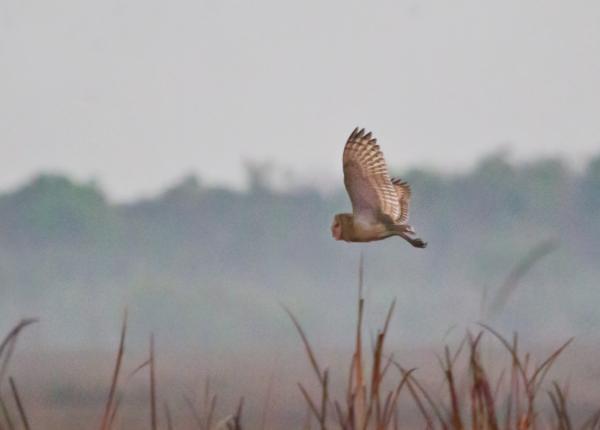Did You Know?
- There are five recognized subspecies of the Eastern Grass-owl
- This species is in the same genus as the Barn Owl
- This owl has also been known as the Australasian Grass-owl or the Chinese Grass-owl
How The Peregrine Fund is Helping
Though The Peregrine Fund does not work directly with Eastern Grass-owl, our efforts in scientific research, habitat conservation, education, and community development help conserve birds of prey around the world. We also supply literature to researchers from our avian research library, which helps scientists around the world gather and share important information on raptor conservation. Our support of the Global Raptor Information Network gives raptor researchers tools to more efficiently conduct their own studies while contributing to a global program. It also provides citizen scientists a way to participate in raptor science and conservation.
Where it Lives
As you might imagine, with a name like "Eastern Grass-owl" this species prefers grassland habitat, including savanna, floodplains and agricultural fields. It is found in parts of Australia, Papua New Guinea, Indonesia, the Philippines, and a few other countries of southern Asia.
What it Does
This lovely owl resembles the more widespread Barn Owl. It has more of an overall light brown coloration, with lovely orange, brown, and white mottling along its wings. Like the Barn Owl, and all the other owls in the Tyto genus, it is known for its facial disc which is in the shape of a heart.
At this point you might be wondering what exactly a facial disc is. A bird's facial disc is composed of many feathers that surround its head and helps direct sound to their ears. To get an idea of how it works, cup your hands behind your ears and listen – sounds will be louder and clearer. Owls can raise these feathers slightly when on the hunt, allowing them to hear the rustle of a mouse in the grass, the flapping of feathers in the night, or the slithering of a snake on a tree branch. These sounds give away the location of prey animals, making it easy for these owls to deftly swoop in to catch a meal.
The Eastern Grass-owl has been described as being shy and reclusive, and for this reason it is often difficult to see.
Why it Needs our Help
This species is categorized as Least Concern. However, that doesn't mean that this species isn't facing any threats, and in fact, in some areas, it appears to be in decline. Loss or fragmentation of its habitat and human persecution are just some of the dangers this owl is facing. The use of rodenticides are also a threat to this owl. When people use poison to control rodent populations, the poisoned rodents usually don't die right away. They become easy prey for a hungry owl. But when an owl consumes a poisoned rat, it also gets exposed. If it eats to many poisoned rats, it will inadvertently consume too much poison and it will die too.
What it Eats
Like many owl species, the Eastern Grass-owl eats a lot of rodents. However, it will feed on marsupials, ground-dwelling birds, reptiles, frogs, and large insect, including grasshoppers. Its hunting technique has been compared to that of harriers - gliding slowly low above the ground. These owls are quite dependent on rodents, and when rodent populations fall sharply, sometimes many individual owls may starve.
Nests, Eggs, and Young
Like most other owl species, the Eastern Grass-owl does not build its own nest. Instead, it nests on the ground. It wisely tends to pick areas that are protected by dense, tall grasses, or other vegetation that helps conceal the nest, eggs, and young. Though a pair of owls will usually nest far away from other nesting owls, they sometimes nest in loose colonies where several pairs are nesting within just a few hundred meters from each other. The female may lay between 3-8 eggs. The eggs must be incubated for around one month. When the owlets hatch they are covered in white down. Around two months later, the young will be ready to leave the nest for the first time.
Eastern Grass-owl and the World Center for Birds of Prey
The World Center for Birds of Prey offers fun ways to learn about raptors. Interactive activities, tours, interesting videos and a children's room with activities from coloring sheets to quizzes to costumes await you. At our visitor center, you can see live owls up close - such as a Verreaux' Eagle-owl or a Western Screech-owl, and learn about the wonderful and interesting adaptations they have in order to survive in their respective habitats. There is also a touch table with owl feathers and other natural objects available for exploration. Though far from Australasian Grass Owl habitat, if you take a stroll along a short nature trail around the center, you may come across other owl species including Barn Owls or even a Northern Saw-whet Owl perched in the trees.
References:
Bruce, M.D. and J. S. Marks (2020). Australasian Grass-Owl (Tyto longimembris), version 1.0. In Birds of the World (J. del Hoyo, A. Elliott, J. Sargatal, D. A. Christie, and E. de Juana, Editors). Cornell Lab of Ornithology, Ithaca, NY, USA. https://doi.org/10.2173/bow.ausgro1.01
Lin, Wen-Loung; Wang, Yin; Tseng, Hui-Yun (2007). "Initial Investigation on the Diet of Eastern Grass Owl (Tyto longimembris) in Southern Taiwan". Taiwania. 52 (1): 100–105. doi:10.6165/tai.2007.52(1).100










